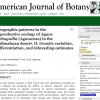
Autores:
Silva-Montellano A.
L. E. Eguiarte
Revista y/o libro:
American Journal of Botany
Volumen:
90, 700-707
Año:
2003
Sinopsis:
Plants with natural variation in their floral traits and reproductive ecology are ideal subjects for analyzing the effects of natural selection and other evolutionary forces on genetic structure of natural populations. Agave lechuguilla shows latitudinal changes in floral morphology, color, and nectar production along its distribution through north-central Mexico. Both the type and abundance of its pollinators also change with latitude. Using starch electrophoresis, we examined the levels and patterns of variation of 13 polymorphic allozyme loci in 11 populations of A. lechuguilla. The overall level of genetic variability was high (He = 0.394), but the levels of genetic variation had no geographic pattern. However, the southern populations exhibited an excess of heterozygotes in relation to expectations for Hardy-Weinberg equilibrium, whereas the northern populations had an excess of homozygotes. Total differentiation among populations was low ( = 0.083), although gene flow estimates (Nm) varied among groups of populations: southern populations had the lowest levels of genetic differentiation, suggesting high levels of gene flow; northern populations had greater levels of genetic differentiation ( = 0.115), suggesting low gene flow among them. The patterns and inferences of the genetic structure of the population at the molecular level is consistent with variation in floral traits and pollinator visitation rates across the range of the species.